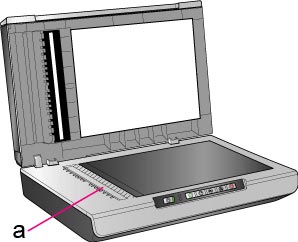

Epson scanning black lines professional#
In the Professional Mode, select None for the B&W Option setting. Select Black&White as the Image Type setting. Align the vertical and horizontal lines with the scales at the top and side of the document.

Make sure the document orientation is perfectly aligned along the document table. Place a transparent sheet, such as an overhead projector sheet, between the document and the document table.

In the Professional Mode, set the Screen Ruling of the Descreening Filter setting to an appropriate setting for your document.Ĭlear Unsharp Mask Filter in the Professional Mode main window. Select the Descreening Filter check box in the Home Mode or the Professional Mode main window. It is a result of interference that occurs due to the difference between the pitches of the scanning and the halftone screens. Selecting the product may cause on-screen colors to be different from the colors of the original however, the colors will be reproduced correctly when the image is printed.Ī moiré is a cross-hatch pattern that appears on the scanned images when you scan printed materials. In the Home Mode, select Screen/Web as the destination. Cover the edges of the document with paper to block the external light.Īdjust your software's Gamma setting using the Histogram Adjustment dialog box in the Professional Mode.Ĭheck your software's Brightness setting using the Image Adjustment dialog box in the Home Mode, or the Histogram Adjustment dialog box and the Image Adjustment dialog box in the Professional Mode.Ĭheck the brightness and contrast settings of your computer display.Ĭhange the Display Gamma setting of scanned image for your output device, such as a monitor or product, in the Configuration dialog box.Ĭhange the Destination setting in the Home Mode or the Professional Mode main window. A document that is wrinkled or warped may not be scanned well.Ī document that is very thick or warped at the edges can cause discoloration. If this happens on part of the image, make sure the document is uniformly flat against the document table. Select Color Control and also check Continuous auto exposure in the Configuration dialog box, or adjust the Exposure setting using the Auto Exposure button in the Professional Mode main window.Ĭhange the Resolution setting for your document. If moiré patterns appear in the image, see Moiré (cross-hatch) patterns appear in the scanned image. Select Unsharp Mask Filter in the Professional Mode main window. Make sure the product is on a flat, stable surface.Ĭhange the Display Gamma setting of the scanned image for your output device, such as a monitor or the product, in the Configuration dialog box. Make sure you do not accidentally move the document while scanning. Make sure the document is flat against the document table.ĭo not place heavy objects on the document table. Align the vertical and horizontal lines with the scales at the top and side of the document table. Make sure the document orientation is perfectly straight on the document table. If this happens on both your screen image and printout, this indicates that the document table may be dusty or scratched. If a line is missing on both your screen image and printout, this indicates the scanner sensor is malfunctioning. When scanning with the Black&White setting in the Home Mode or the Professional Mode, change the Threshold setting. Make sure the document is placed on the document table of the product, with the side to be scanned facing down. Try one or more of the following solutions. The transportation lock must always be set in the unlocked position except when transporting the product. Make sure if the transportation lock on the left side of the document table is set in the unlocked position. We recommend that you use the film holder for films. These values are used for reflective documents. The area with a width of 1.5 mm from both horizontal and vertical rulers cannot be scanned. Place the document away from the edges of the document table to avoid any unwanted image cropping. The scanned image differs from the original. Images cannot be located properly in the Thumbnail preview. Scanned images cannot be printed or come out garbled when printed. The image is larger or smaller than the original. Poor character recognition during OCR scanning. Moiré (cross-hatch) patterns appear in the scanned image. When scanning an original, straight lines in the image come out jagged.Ĭolors are patchy or distorted at the edges of the image. Document is not scanned or only a few dots appear as the scanned image.Ī line of dots is always missing from the scanned image.Ī line of dots always appears in the scanned image.īlack vertical lines appear on the scanned image or the image is all black.


 0 kommentar(er)
0 kommentar(er)
